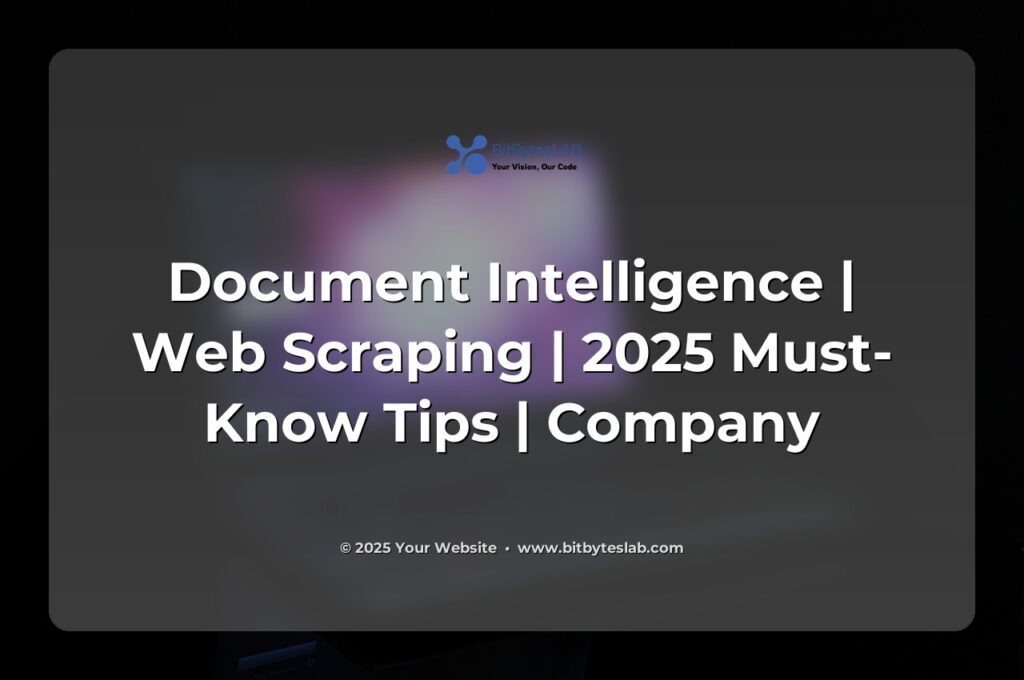🚀 Imagine you’re a data engineer standing at the edge of a massive digital ocean, where every click, every pixel, and every line of code could unlock a treasure trove of insights. In 2025, that ocean is deeper than ever, but with the right tools, strategies, and a dash of humor, you can navigate it like a seasoned sailor. Let’s dive into the world of Document Intelligence and Web Scraping, the twin engines powering modern data pipelines.
⚡ In a recent survey, 71% of Fortune 500 companies reported that their competitive edge hinged on real‑time data extraction from external sources. Yet, half of them still grapple with scattered, noisy data and manual review bottlenecks. The problem? Traditional scraping and extraction methods are brittle, slow, and often legally gray.
At its core, Document Intelligence (DI) is the art of turning chaotic documents—PDFs, scanned invoices, email threads—into clean, structured datasets. Web Scraping is the launchpad that feeds DI pipelines, harvesting raw HTML, APIs, and dynamic content from the web. Together, they form a virtuous cycle: scrape, extract, enrich, store, and let business decisions flow.
⚡ A SQL query goes into a bar, walks up to two tables and asks… ‘Can I join you?’ 🍺

🔧 Crafting a resilient scraping architecture means embracing a multi‑layered approach. Start with a discovery phase: map target URLs, detect pagination, and observe authentication flows. Then layer your request engine—toggle between `requests` for static pages and headless browsers like Playwright when JS renders the data you need. Keep a proxy pool in rotation and pair it with realistic user agents to stay under the radar.
Once the raw data lands, the extraction layer kicks in. Hybrid tactics—combining XPath for stable structures with LLM prompts for ambiguous layouts—offer the best of both worlds. Validate every field against a JSON schema, normalize dates, and deduplicate records before they hit downstream storage. The result? Data that’s ready for analytics, modeling, or policy compliance in a single click.
📊 Industry insights show that 63% of enterprises now use AI‑driven extraction for semi‑structured documents, cutting manual review time by 70%. Meanwhile, 47% of scraping operations have migrated to serverless functions, slashing infrastructure costs by up to 30%. These numbers underline a pivotal shift: speed, intelligence, and cost efficiency are the new KPI trifecta.
💻 How many programmers does it take to change a light bulb? None, that’s a hardware problem! 💡

💡 Think of your scraping stack as a well‑orchestrated orchestra. Each instrument—headless browsers, APIs, OCR engines, LLM inferencers—plays its part, but the conductor (your orchestration layer) ensures harmony. Using workflow engines like Airflow or Prefect, you can schedule incremental crawls, keep stateful checkpoints, and trigger downstream AI models precisely when new data arrives.
📈 The business upside is hard to ignore. A retail firm that implemented real‑time price monitoring saw a 15% reduction in markdown losses. A financial regulator that automated SEC filing extraction cut compliance review time from weeks to days. And a global insurer that converted paper claims to structured datasets achieved an 80% drop in manual entry—freeing analysts to focus on risk modeling.
😬 Common challenges—anti‑scraping defenses, dynamic content, and schema drift—don’t have to be roadblocks. Instead, treat them as opportunities to innovate: deploy stealth mode headless browsers, leverage GraphQL to bypass heavy rendering, and maintain a selector registry in Git. Pair these tactics with continuous monitoring: auto‑alert on extraction failures, and retrain LLM prompts when drift is detected.
🔮 Looking ahead, 2025 is shaping up to be a year of convergence. LLM‑driven extraction will move from niche to mainstream, allowing zero‑shot parsing of any document type. Edge computing, powered by Cloudflare Workers or Fastly Compute@Edge, will bring scraping closer to data sources, slashing latency and bypassing IP bans. And privacy‑preserving frameworks—differential privacy, federated learning—will make it possible to extract insights from sensitive documents without violating GDPR or CCPA.
🚀 In the fast‑moving landscape of data extraction, the companies that thrive are those who treat scraping and document intelligence not as chores, but as strategic assets. They blend rule‑based parsing with modern AI, orchestrate pipelines like symphonies, and never lose sight of compliance.
🌟 If you’re ready to elevate your data pipeline from brittle scripts to a robust, AI‑augmented engine, BitBytesLab is here to help. With decades of experience in web scraping, OCR, and DI, we turn raw digital noise into clean, actionable intelligence—so you can focus on what really matters: turning data into decisions.





